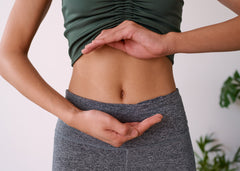Whether you think your period might be coming for the first time or it takes you by surprise, it can be a nerve-wracking experience! Here’s a breakdown of what you need for your period, the details on how your period works, and what to do if it comes unexpectedly.
Your First Period
You might experience some cramping or feel that your stomach is bloated as signs your period is coming. Maybe you’ve been feeling a little sad or cranky, extra hungry, or having acne breakouts lately and you weren’t sure why.
Just before your period (or menstrual cycle), hormonal changes can cause Premenstrual Syndrome, or PMS, but as the hormone levels even out in the first few days of your period, PMS symptoms disappear. You can lessen symptoms of PMS with hormone balancing herbal tea and eating some dark chocolate!
How long does a period last?

Usually, a first period is very light. The bleeding may only last around 2 days, but it could be up to a week. If it’s longer, particularly if it’s still heavy after 7 days, talk to a parent or healthcare provider.
It might be a few spots of bright red blood or a sticky stain that shows up in your underwear. It might be red, brown, or even black. The bleeding itself doesn’t hurt, though if you experience cramping then that can be uncomfortable. The blood may be surprising and it may look like a lot, but it is really only around 3 tablespoons over the course of your whole period.
Will people know I'm having my period?
Nobody will know that you’re on your period unless you choose to tell them.
It’s probably a good idea to tell your mom or another trusted adult. Your mom will be able to tell you what her first period was like and can give you advice or help if you need it.

Are there things I can't do when I'm on my period?
Honestly, you can do the majority of activities you love once you're used to dealing with your period! You can play sports (exercise can help with cramps and other symptoms), take a shower or bath (staying clean is important at this time!), and even swim while on your period (depending on which products you use to manage your period).
What is a menstrual cycle?
So you may have learned a little bit in school or from your friends. Here’s all the basic info you need to know about how your body is changing now to prepare you for your future!
The Female Cycle
Our bodies have an amazing design to be able to get pregnant and have children!
When a woman’s body works correctly, she is able to pass an egg once a month through her ovary, that will either be fertilized and grow into a baby, or not fertilized and pass out of her body through a period.
The egg you release can only be fertilized by sperm from a male. If you have questions about how an egg becomes fertilized, please find your parent or a trusted adult to talk with about this process!
Some important things to know:
• The first day that you start bleeding signals the start of your menstrual cycle. The cycle ends and restarts the moment your period begins the next month, usually about 28-30 days later.
• Your body is going through these changes because hormones, or chemical signals sent through your blood, are telling your ovaries (they hold the eggs) and uterus (accepts the egg) to grow and prepare for pregnancy every month. Then your hormones signal to release the egg and get rid of those parts - or shed the lining of your uterus - to restart the process the next month if you are not pregnant.
• When you first start having a period, it’s called menarche, and when you stop having a period, it’s called menopause. The only thing that’s causing the changes in your body is your hormones.
Hormones are crazy cool, because they can play a part in everything from your hair and skin issues to how your digestion works to headaches and how your emotions make you feel! A woman’s body has higher levels of the hormone estrogen, which controls your ability to have babies, among other things.
The four phases of menstruation
A menstrual cycle is counted from the first day you get your period one month to the first day you get your next period. It has four phases: your menstrual phase (your period) - which is included in the follicular phase - the ovulation phase, and the luteal phase.
Before we explain the different phases your body will go through during your cycle, here’s a picture that shows you where all the parts of your reproductive system are for reference:

The ovaries hold your eggs, which get released each month. The egg travels down the fallopian tube towards your uterus - which is the womb a baby will grow in if you are pregnant. The endometrium is the lining of your uterus which will be shed and passed out of your body during your period if you are not pregnant. Your cervix is the hole inside your body that the blood, endometrium, and egg flows through, into your vagina, and out of your body during your period.
The average cycle is 28 days, but anything from 21-45 days is considered normal. And it may take up to 6 years or even longer for your period to become "regular." Have your mom or trusted adult check out our hormone balancing herbal tea — it can help your body regulate your cycle and reduce symptoms of PMS!

During the follicular phase (10-22 days), hormones cause the lining of the uterus (where an egg would grow into a fetus) to become thicker with extra blood and tissue. This phase lasts from the first day of your period to when you start to ovulate.
In the ovulation phase (24 hours), one of your ovaries releases an egg. The egg will travel down your fallopian tube toward your uterus. If the egg is fertilized, the egg will attach to your uterus, or womb, and grow into a baby!
In the Luteal phase (12-14 days), your uterus will thicken to prepare for a potential pregnancy (when the egg meets sperm).
When the egg is not fertilized, the menstrual phase happens again, and the egg, endometrium (or uterus lining), and blood flow out of your body through your vagina and then the whole process starts with the follicular phase again.
Tracking Your Cycle
It is a good idea to track your period to find your body's pattern, to tell when you can expect your next period. Simply put an X on a calendar each day that you are bleeding, or consider checking online or on your smartphone for apps to help you.

Accessories for Your Period
There are a few products that you can choose from to manage bleeding during your cycle. You may find that you want to start with pads for a few months and only incorporate tampons or cups as you feel more comfortable with your period and your body.
Definitely talk with your mom or mother figure if you're feeling unsure. No matter what you use, don’t forget to wash your hands before and after changing your sanitary product.

Here's a little bit about how each product works —
Reusable Pads. While disposable pads are available and work well, we encourage using reusable pads to be environmentally friendly during each cycle and save money in the long-run! Change the pad every 4-6 hours or whenever full. If using reusable pads, you can fold and store them in a waterproof bag while out and about or rinse and then store until you're ready to wash them. When you're ready to wash your pads, feel free to spray or soak with hydrogen peroxide first to remove stains (our soft charcoal bamboo pads are naturally stain resistant!) wash by hand or throw them right in the washing machine. Air dry or machine dry with low heat.
Disposable Tampons. If you feel comfortable inserting something into your vagina, you can consider organic cotton disposable tampons. But it may take some practice and may not be comfortable for you for a few years — don't feel like you have to use tampons just because your friends are. But also know that tampons will not cause loss of virginity and cannot get lost inside the body.
It is very important to use the smallest size possible and to change them every 4-8 hours to lower risks associated with Toxic Shock Syndrome. Since tampons are worn internally, you can participate in almost any activity, including swimming, while wearing one.
One risk to be aware of with tampons, as opposed to other kinds of menstrual care, is the tiny fibers in tampons (even organic!) can cause micro tears in the vaginal lining and leave behind small fibers that increase risks of Toxic Shock Syndrome (TSS). In case you couldn't tell, they're not our favorite period care option for health and environmental reasons - but they're a popular option to be aware of nonetheless!
Reusable tampons are made from soft sea sponges and absorb the blood from your period in the same way that disposables do, but with less health risks associated with conventional tampons. When using a sea sponge tampon, you'll wet it to make it soft, squeeze out excess water, and push it in vaginally. Once it starts to feel full, remove it, rinse it out, and reinsert - be sure to sanitize daily!

Menstrual cups are small cups that you fold and insert into your vagina, like a tampon. These cups collect blood flow, rather than absorbing it and can be worn for up to 12 hours or until they are full. They can be emptied into the toilet or sink, rinsed, and reinserted.
The Easy-Empty Menstrual Cup is a unique cup that can be worn for an extended period of time, since it can be emptied without removing it by releasing the valve when the cup is full! You'll know it is full when the pressure starts to build.
Like tampons, cups are worn internally, so you can participate in all activities while on your period, but they offer you a healthier and more earth friendly alternative as they are gentler on your delicate vaginal walls, do not dry you out, and do not leave behind tiny fibers that could increase risk of infection.
What if you don’t have any of those?
If you start your period and you don’t have any feminine hygiene products with you, you can always use toilet paper to make a temporary pad. Simply wrap the toilet paper around the crotch area of your underwear to make a temporary liner.
Safety Note: Never insert toilet paper in your vagina.
How to Handle a Period Accident
One of the hardest parts about waiting for your period to start is not knowing when it’s going to happen! What if you’re in class, or out with friends, or wearing something white?!
It’s always a good idea to be prepared if you think you’re going to be starting your period soon. Have your mom or trusted adult in your life help you make a “period kit” with a few pads, a change of underwear, some tea packs to help with period cramps, a water bottle, and a dark chocolate bar.
Keep that kit in your backpack, locker, or somewhere else that will be easily accessible on a daily basis.
If you do leak through your clothes, don’t feel bad. It has happened to almost every woman at some point!
If you have an extra layer, wrap it around your waist. Ask a friend to walk behind you on the way to the bathroom. Make your way to the nearest change of clothes, whether that means going to your locker or heading home. Soaking your underwear or other clothes in cold water (never hot water) can help stop blood stains from setting, and hydrogen peroxide can remove blood stains on clothing.
Make sure that you change your feminine product on a regular basis. Don’t wait because you are busy — your period doesn’t care about that!
Periods are a manageable part of life that mean you’re growing into womanhood. If you have any other questions about periods and how to take care of your body, speak with your mom, grandmother, or another trusted adult on what to expect and how to manage this time of change in your life!








